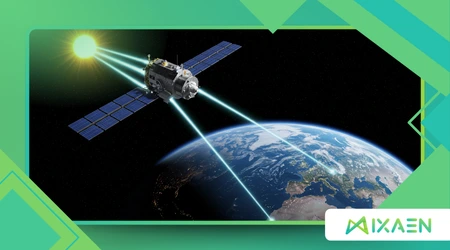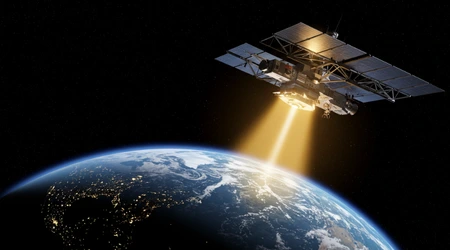Could We One Day Use the Sun’s Energy Directly from Space?

The idea of harnessing solar power in orbit and beaming it down to Earth is no longer purely science fiction; it is rapidly moving into the realm of viable engineering.
Anúncios
The potential to Use the Sun’s Energy Directly from Space represents perhaps the single greatest leap in clean energy technology.
Unlike terrestrial solar farms, space-based solar power (SBSP) is unaffected by weather, atmospheric filtering, or the day-night cycle. This translates into near-constant power generation.
Major global powers, including China, Japan, the UK, and the US, are now engaged in a new kind of “space race.” They are heavily funding demonstrator projects with the ambitious goal of achieving gigawatt-scale power transmission within the next two decades.
This comprehensive article delves into the technology, challenges, and monumental implications of learning to Use the Sun’s Energy Directly from Space.
Anúncios
Why Is Space the Ideal Place for Solar Collection?
Moving solar panels from Earth’s surface to geostationary orbit (GEO) offers several non-negotiable advantages that address the primary limitations of conventional solar energy.
What Are the Key Advantages of Orbital Collection?
In space, the sun’s radiation intensity is significantly higher because it bypasses the filtering effects of the atmosphere. Panels receive approximately 30% more sunlight than they would on the ground.
Critically, a satellite in a geostationary orbit (36,000 km up) remains stationary relative to a point on Earth. It can capture sunlight for up to 99% of the year, avoiding the 12-hour outage cycle that limits ground solar.
This continuous energy stream solves the fundamental storage problem inherent to terrestrial renewables. The ability to guarantee power, day and night, makes the effort to Use the Sun’s Energy Directly from Space revolutionary.
++ Why Solar Activity Peaks Every 11 Years
How Does Constant Power Address Grid Stability Issues?
Terrestrial renewables like wind and solar are intermittent, requiring massive, expensive battery storage systems or reliable backup power (often gas) to stabilize the electric grid. SBSP offers a stable, predictable, baseload source.
The continuous nature of the orbital power feed means it can be integrated into the existing grid infrastructure more easily than intermittent sources. This drastically reduces the capital costs associated with grid modernization.
The value proposition shifts from just generating clean energy to providing reliable, 24/7 clean energy, which is essential for industrial stability and national energy security.

How Does Wireless Power Transmission Work?
The biggest technological hurdle in this massive endeavor is safely and efficiently getting the collected energy from orbit to a receiving station on Earth.
What Are the Primary Methods for Beaming Energy to Earth?
The two main contenders for long-distance, wireless power transfer (WPT) are microwaves and lasers, each presenting a distinct set of trade-offs in efficiency and safety.
Also read: Solar Cycle 25 sunspot progression
The Microwave Transmission Method
Microwave transmission is the most mature WPT technology, having been successfully demonstrated by Caltech’s Space Solar Power Demonstrator (SSPD) in 2023. Energy is converted to radio frequency (RF) waves.
These waves are focused by a large transmitting antenna and sent to a ground-based receiving antenna, called a ‘rectenna,’ which efficiently converts the microwaves back into electricity. The lower frequency allows the waves to pass through clouds and light rain with minimal power loss.
Example 1 (Microwave): The Japanese JAXA/OHISAMA project, scheduled for further testing in 2025, aims to test a planar array design to demonstrate high-efficiency microwave beaming, moving us closer to practical methods to Use the Sun’s Energy Directly from Space.
Read more: Double X-Class Flares: Recent Events, Effects, and How Scientists Monitor Them
The Laser Transmission Method
Laser transmission utilizes high-power lasers, which can focus the energy into a much smaller beam than microwaves. This drastically reduces the size of the required ground receiver (rectenna).
However, lasers are easily attenuated by clouds and atmospheric turbulence, making them less reliable than microwaves for continuous terrestrial power. Laser transmission efficiency also presents a persistent engineering challenge.
Research continues on laser transmission because its smaller receiver footprint offers logistical benefits, particularly for powering remote military bases or disaster areas.
What Are the Major Obstacles to Commercialization?
While the physics works, the engineering and economics of deploying orbital power plants remain daunting.
Why Is the Launch Cost the Single Biggest Hurdle?
Building a gigawatt-scale orbital power station requires launching thousands of tons of material, including massive, ultra-lightweight solar arrays and the transmission antenna.
The Rocket Equation and Mass Problem
Even with falling launch costs, the sheer mass of the materials needed to build a solar array spanning several square kilometers makes the initial investment astronomical. Launch costs must fall to an estimated $100/kg to make the power cost-competitive with terrestrial sources.
The long-term success of the ability to Use the Sun’s Energy Directly from Space is directly tied to the development of fully reusable, super-heavy lift vehicles like SpaceX’s Starship. The economics hinge entirely on reducing the cost-to-orbit ratio.
Public Perception and Safety Concerns
The public remains naturally wary of large beams of microwave energy traversing the atmosphere. Rigorous, transparent safety studies must be conducted to prove the power density is harmless to humans, wildlife, and aviation.
The ground-based rectenna sites require a large exclusion zone. Managing public perception regarding the safety of the beam is as crucial as solving the engineering problems for the successful implementation of SBSP.
The Path to Implementation and Economic Impact
Despite the challenges, countries are making significant, measurable progress toward deployment, recognizing the immense strategic and economic value.
Which Nations Are Leading the SBSP Race?
Global investment in SBSP is accelerating, with several nations setting concrete development timelines and committing substantial funding.
| Nation/Program | Key Goal/Milestone | Target Timeline for Demonstration | Primary Focus/Technology |
| China | Orbital solar station prototype (MW-scale) | 2030s | Geostationary Orbit (GEO) |
| Japan (JAXA) | In-orbit wireless power transmission demonstration | 2025 (Test Mission) | High-Efficiency Microwave (OHISAMA) |
| UK (Cassiopeia) | Demonstration of component technologies & economic model | 2035 | Modular, Commercial Viability |
| USA (Caltech/NASA) | Successful in-space power transmission (SSPD-1) | Achieved 2023 | Lightweight, Flexible Arrays |
The Economic and Geopolitical Imperative
Securing a continuous, unlimited energy source from space provides unprecedented energy independence, minimizing reliance on volatile global fossil fuel markets.
The nation that successfully deploys the first commercial SBSP station will gain a massive geopolitical advantage, potentially becoming a primary energy exporter in the late 21st century. The investment in the ability to Use the Sun’s Energy Directly from Space is therefore a matter of national security.
Analogy: Relying on terrestrial solar is like collecting rainwater in a bucket, necessary but limited. Learning to Use the Sun’s Energy Directly from Space is like tapping into a massive, constantly flowing orbital river the supply is virtually endless and entirely under our control.
Conclusion: The Horizon of Unlimited Power
The shift from speculative concept to active engineering development marks a critical turning point for the future of global energy.
While the financial investment is vast and the launch challenges monumental, the reward guaranteed, 24/7 clean power is worth the cost. Current research, successful demonstrators by Caltech and impending tests by Japan, confirm the technology is feasible.
The next ten years will focus on driving down launch costs and scaling the hardware. The quest to Use the Sun’s Energy Directly from Space is not just about solving climate change; it is about providing humanity with a limitless, reliable power source that will define the next industrial revolution.
What do you believe is the single biggest technological challenge launch costs or transmission efficiency that must be overcome to realize this dream? Share your thoughts and join the discussion in the comments!
Frequently Asked Questions (FAQ)
Q: How much power can a space solar farm generate?
A: The design goal for most planned commercial Space-Based Solar Power (SBSP) plants is to deliver 1 to 2 Gigawatts (GW) of continuous power to the grid. This is comparable to a large nuclear or gas power plant.
Q: Is the microwave beam dangerous if I fly through it?
A: Safety is paramount. The current designs ensure the power density on the ground is extremely low, similar to ambient sunlight, and non-ionizing. The intense focus of the beam is precisely controlled to avoid populated areas and aviation routes.
Q: Will space solar power replace terrestrial solar panels?
A: No. Space-based solar power is intended to be a baseload energy source, providing the stable, continuous power that complements intermittent terrestrial renewables like wind and conventional solar. Both are necessary for achieving net-zero goals.
